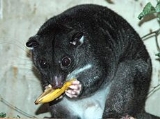
Phalangerida
Encyclopedia
Phalangerida is one of the two former suborders of the large marsupial
order Diprotodontia
. This large and diverse suborder included kangaroo
s, wallabies
, quokka
s, possum
s, gliding possum-like marsupials and others. The much smaller suborder Vombatiformes
encompasses only the koala
s and wombat
s. This suborder is no longer considered to accurately describe the diversity in Diprotodonta.
Phalangeriformes has come to replace Phalangerida but does not include the potoroo
s (Potoroidae
), kangaroo
s and wallabies
(Macropodidae) or the musky rat kangaroo (Hypsiprymnodontidae
). These families are now placed in a new suborder named Macropodiformes
.
Marsupial
Marsupials are an infraclass of mammals, characterized by giving birth to relatively undeveloped young. Close to 70% of the 334 extant species occur in Australia, New Guinea, and nearby islands, with the remaining 100 found in the Americas, primarily in South America, but with thirteen in Central...
order Diprotodontia
Diprotodontia
Diprotodontia is a large order of about 120 marsupial mammals including the kangaroos, wallabies, possums, koala, wombats, and many others. Extinct diprotodonts include the rhinoceros-sized Diprotodon, and Thylacoleo, the so-called "marsupial lion"....
. This large and diverse suborder included kangaroo
Kangaroo
A kangaroo is a marsupial from the family Macropodidae . In common use the term is used to describe the largest species from this family, especially those of the genus Macropus, Red Kangaroo, Antilopine Kangaroo, Eastern Grey Kangaroo and Western Grey Kangaroo. Kangaroos are endemic to the country...
s, wallabies
Wallaby
A wallaby is any of about thirty species of macropod . It is an informal designation generally used for any macropod that is smaller than a kangaroo or wallaroo that has not been given some other name.-Overview:...
, quokka
Quokka
The Quokka , the only member of the genus Setonix, is a small macropod about the size of a domestic cat. Like other marsupials in the macropod family , the Quokka is herbivorous and mainly nocturnal...
s, possum
Possum
A possum is any of about 70 small to medium-sized arboreal marsupial species native to Australia, New Guinea, and Sulawesi .Possums are quadrupedal diprotodont marsupials with long tails...
s, gliding possum-like marsupials and others. The much smaller suborder Vombatiformes
Vombatiformes
Vombatiformes is one of the three suborders of the large marsupial order Diprotodontia. Five of the seven known families within this suborder are extinct; only the families Phascolarctidae, with the Koala, and Vombatidae, with three extant species of wombat, survive.Among the extinct families are...
encompasses only the koala
Koala
The koala is an arboreal herbivorous marsupial native to Australia, and the only extant representative of the family Phascolarctidae....
s and wombat
Wombat
Wombats are Australian marsupials; they are short-legged, muscular quadrupeds, approximately in length with a short, stubby tail. They are adaptable in their habitat tolerances, and are found in forested, mountainous, and heathland areas of south-eastern Australia, including Tasmania, as well as...
s. This suborder is no longer considered to accurately describe the diversity in Diprotodonta.
Phalangeriformes has come to replace Phalangerida but does not include the potoroo
Potoroo
The Potoroo is a kangaroo/rat like animal about the size of a rabbit. All three extant species are threatened, especially The long-footed Potoroo and Gilbert's potoroo...
s (Potoroidae
Potoroidae
The marsupial family Potoroidae includes the bettongs, potoroos, and two of the rat-kangaroos. All are rabbit-sized, brown, jumping marsupials and resemble a large rodent or a very small wallaby.- Characteristics :...
), kangaroo
Kangaroo
A kangaroo is a marsupial from the family Macropodidae . In common use the term is used to describe the largest species from this family, especially those of the genus Macropus, Red Kangaroo, Antilopine Kangaroo, Eastern Grey Kangaroo and Western Grey Kangaroo. Kangaroos are endemic to the country...
s and wallabies
Wallaby
A wallaby is any of about thirty species of macropod . It is an informal designation generally used for any macropod that is smaller than a kangaroo or wallaroo that has not been given some other name.-Overview:...
(Macropodidae) or the musky rat kangaroo (Hypsiprymnodontidae
Hypsiprymnodontidae
The Hypsiprymnodontidae are a family of macropods, one of two families containing animals commonly referred to as rat-kangaroos. There is a single known extant genus and species in this family, the Musky Rat-kangaroo, Hypsiprymnodon moschatus, which occurs in northern Australia and New Guinea....
). These families are now placed in a new suborder named Macropodiformes
Macropodiformes
Macropodiformes is one of the three suborders of the large marsupial order Diprotodontia. Kangaroos, wallabies and allies, bettongs, potaroos and rat kangaroos are all members of this suborder.- Classification :...
.

